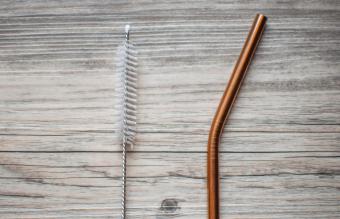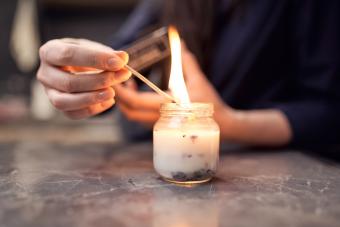
Don't toss that straw just yet. Learn how to clean a straw so you can continue to enjoy this fun and environmentally-friendly way to sip your favorite drinks. You can clean any reusable straw, whether it's made of plastic, silicone, metal, or something else.
How to Clean Straws With a Brush
One of the easiest and best ways to clean a straw is with a special straw brush. You may even have one lying around from when you were cleaning baby bottles and kids' toys. If not, you can pick one up on Amazon or at your local store for about four dollars. Once you have the brush, the process is easy.
- Rinse the straw under warm running water or allow it to soak if it's very dirty. It's best if you can rinse the straw right after use. If not, allow the straw to soak in warm water for a few minutes before rinsing in running water.
- Place a few drops of dish soap on your straw brush and gently slide it into the straw. Move it in and out several times, trying to get all surfaces. If the straw is longer than the brush, clean it from both ends.
- Give the straw a final, thorough rinse to remove all soap.
- Place the straw in an upright position to dry.
How to Clean a Straw Without a Brush
If you don't have a brush and don't have time to get one, don't worry. You can still get your straw clean with items you have around your home. Hit up the kids' craft supplies and find pipe cleaner. It doesn't matter what color it is.
- Rinse the straw well, allowing it to soak if it has dried-on gunk.
- Get the pipe cleaner wet and add a few drops of any brand of dish soap to the last few inches of the pipe cleaner.
- Insert the soapy end of the pipe cleaner into the straw and begin moving it in and out. Continue until the straw is clean.
- Rinse the straw thoroughly and place it upright to dry.
Cleaning Different Types of Straws
Reusable straws come in many different shapes and materials. Your cleaning process may vary slightly, depending on the type of straw.
Straight Plastic Straws
Follow the processes above, since these are among the easiest straws to clean. Avoid heat-drying plastic straws, as high heat can melt or weaken the plastic. Air dry instead.

Curly Plastic Straws
Curly plastic straws are some of the most difficult reusable straws to clean. Never put them in the dishwasher, since the heat will damage them. Instead, find a very long pipe cleaner and use the method described above for cleaning a straw without a brush. Clean from both ends.

Silicone Straws
Silicone straws, like the type in many reusable water bottles, can withstand high heat. However, this material can be fragile if you handle it roughly. Use extra care inserting the straw brush or pipe cleaner, being cautious about poking the metal through the straw.

Metal Straws
Straws made of metal like stainless steel are some of the easiest to clean. They are strong and durable, and they aren't sensitive to heat. However, you can't see inside this type of straw to make sure it's clean. When you think you're done cleaning it, hold the straw up to the light and look through it. Examine the inside surface for bumps or signs of dirt. Continue cleaning until these are gone.

Bamboo Straws
Bamboo straws are a great, environmentally-friendly alternative to plastic, but they are trickier to clean. Instead of using soap and a straw cleaner, place the straws in a jar of water and shake it. If the straw is very dirty, place it in boiling water with a little homemade vinegar cleaner to kill germs. Always dry bamboo straws lying down and store them in a well-ventilated location to avoid mold.

Hacks for Cleaning Very Dirty or Germy Straws
If someone has left milk or a smoothie in the straw, it may be very difficult to clean. What's more, mold can grow in clean straws if water remains in the straw when you put it away. There are a few tricks that can help:
- Use a mild abrasive on the straw cleaner. Baking soda works well for scraping off dried-on smoothie gunk.
- If the straw is moldy and is made of plastic, silicone, or metal, soak it in a mild bleach solution to kill germs.
- Dry clear straws in the sun so the sunlight can help destroy germs.
- If the straw has chunks in it after cleaning, fill it with water and then use your mouth to forcefully blow the water out into the sink. Always blow out so you don't consume the dirty water.
Other Environmentally Friendly Straw Alternatives
If you're tired of cleaning reusable straws but still want to choose an environmentally-friendly alternative to disposable plastic straws, consider biodegradable drinking straws. These straws don't stick around in landfills and may be less harmful to the environment than plastic alternatives. Whether you choose biodegradable straws or simply clean your reusable straws using these methods, you can rest assured your sipping isn't hurting the planet.







